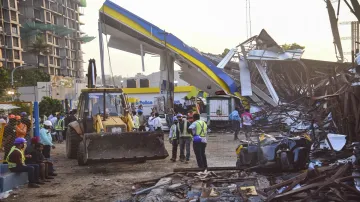Mumbai hoarding collapse: After the hoarding collapse incident which claimed 14 lives and injured several others, the Brihanmumbai Municipal Corporation (BMC) issued a notice to an advertisement agency, asking it to immediately remove the remaining three hoardings near the spot in Ghatkopar area. According to officials, the notice has been issued to M/s Ego Media for installing the hoarding that collapsed on the petrol pump during the gusty winds on Monday evening.
According to civic officials, the billboard was illegal which got uprooted and fell on a petrol pump at the Cheddanagar Junction in Ghatkopar amid gusty wind and rain. The Assistant Police Commissioner (Admin) had reportedly given permission for erecting the four hoardings on behalf of the Commissioner of Railway Police, Mumbai, including the one which collapsed on Monday, but no official permission or NOC was obtained from the BMC.
India TV delved into the possible causes behind the collapse of a towering billboard and startling revelations came to light. The billboard stood at a towering height of 100 feet and measured 120×120 in size, with a weight exceeding 5 tons.
Here are five potential reasons behind hoarding collapse
First reason:
During the incident, the billboard toppled over, bringing down its foundation along with it. The location where the billboard was erected has marshy soil. Initial reports suggest that soil testing was neglected during the construction phase, meaning the soil quality wasn't assessed beforehand.
Second reason:
With a towering height exceeding 100 feet, the construction of a robust foundation for the billboard should have been paramount. Ideally, for such a height, the foundation ought to have reached a depth of at least 7-8 meters into the ground. However, it has been revealed that in this instance, the foundation fell significantly short, measuring less than 3 meters in depth.
Third reason:
The construction regulations mandated the foundation to be entirely made of concrete material. However, in this instance, the foundation was constructed using soil and large stones, with minimal use of concrete. Had proper concrete material been utilized as required, it's possible that the billboard wouldn't have been uprooted during a severe storm.
Fourth reason:
In Mumbai, the BMC strictly prohibits billboards larger than 40×40 feet. However, in this instance, the billboard was approximately 120×120 feet in size. Situated on GRP (Government Railway Police) land, the billboard company obtained permission solely from the Railway Police, neglecting to seek approval from the BMC. Additionally, there exists several acres of open area in front of the billboard. When the storm struck, the excessive wind pressure exerted directly onto the oversized billboard. If the billboard had adhered to standard size regulations, it might have been better equipped to withstand the force of the wind.
Fifth reason:
Given the considerable height of the billboard, proper ventilation should have been incorporated into its design. However, in this case, no provisions for air passage were made. Consequently, when the storm hit, the full force of the powerful wind was exerted directly onto the billboard, exacerbating the strain on its weak foundation and lack of ventilation. The absence of adequate ventilation and the compromised foundation likely contributed to the swift collapse of the billboard.
Mumbai police registers FIR
The official said the land on which the hoarding was erected is the Collector land and it was in possession of Police Housing Welfare Corporation of the Government of Maharashtra as per the property card records. Meanwhile, Mumbai Police registered a case against the owner of Ego Media and others. The owner, Bhavesh Bhinde, and others were booked under sections 304 (Culpable homicide not amounting to murder), 338 (causing grievous hurt by act endangering life or personal safety of others) and 337 (causing hurt to another person by acting rashly or negligently) of the Indian Penal Code.
